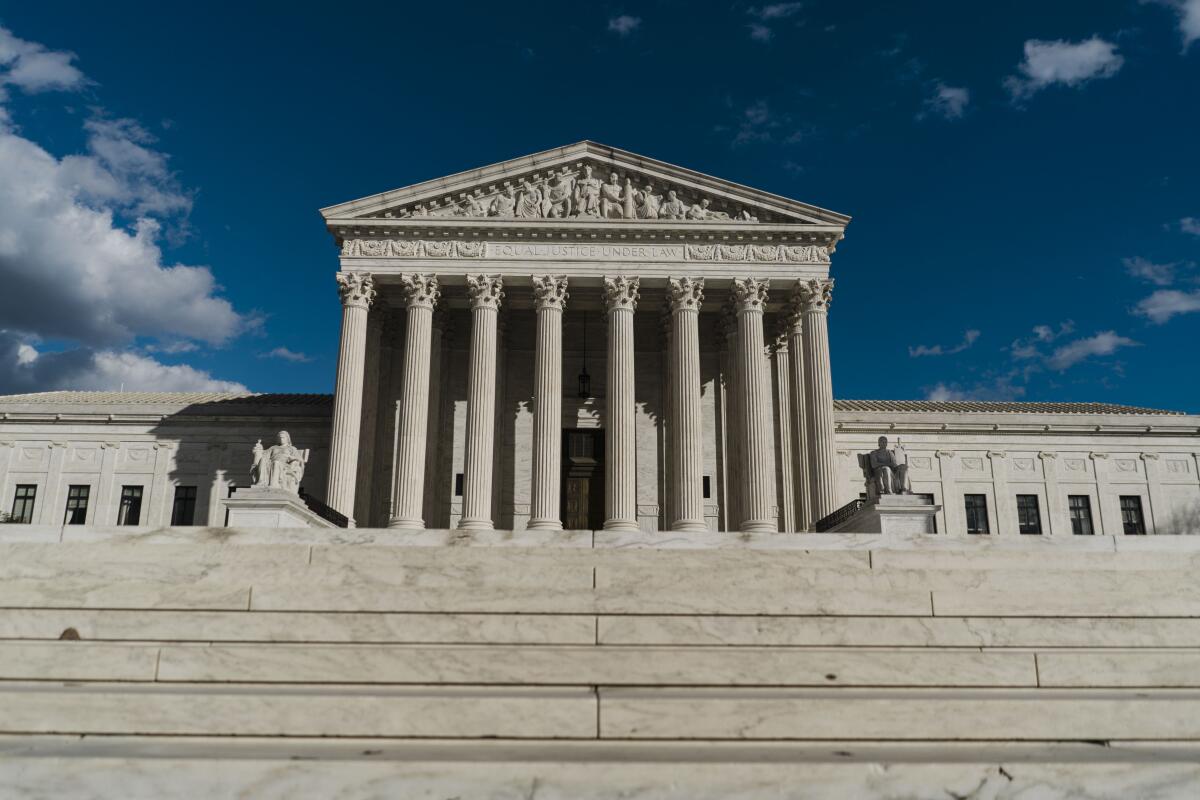Supreme Court weighs new limits on EPA’s power to fight climate change

- Share via
WASHINGTON — The Supreme Court justices on Monday weighed whether to set strict limits on how the Biden administration can fight climate change through new regulations of plants that burn coal to produce electricity.
They did so even though Biden’s Environmental Protection Agency has yet to issue a regulation involving carbon pollution from power plants.
Instead, the justices agreed to reopen a regulatory battle from the Obama and Trump administrations.
At issue is whether the 1970s-era Clean Air Act told the EPA it must focus narrowly on steps that might reduce pollution from old power plants, or whether the agency may regulate broadly by enforcing state-by-state targets on carbon pollution.
The Obama administration followed this broad approach in its Clean Power Plan and believed the pollution targets would push states to phase out coal-burning plants and switch to natural gas, wind turbines and solar power.
But the Supreme Court by a 5-4 vote blocked that plan from taking effect in February 2016, a few days before Justice Antonin Scalia died unexpectedly.
When President Trump took office a year later, the EPA dropped the climate change plan and said it had no authority to go beyond modest measures that directly regulated individual power plants.
Now the scope of the federal authority is back before the court, driven this time by West Virginia and 18 other coal-producing states. They urged the court to take up the issue and to rule that the EPA has quite limited authority to regulate carbon pollution.
The EPA does not have the “power to reshape the nation’s energy sector” nor to “greenlight this transformation” of how electric power is produced, West Virginia’s Solicitor General Lindsay S. See told the court.
Only the court’s three liberal justices sharply questioned her during a two-hour argument.
West Virginia Atty. Gen. Patrick Morrisey called the regulatory dispute “one of the most important administrative law and separation of powers cases in quite some time. This case will determine who decides the major issues of the day: unelected bureaucrats or Congress, comprised of those elected by the people to serve the people.”
Congress has repeatedly failed to enact new legislation that would authorize significant steps to address climate change.
But environmentalists were shocked and surprised when the court in the fall voted to hear the case of West Virginia vs. EPA, even though there was no regulation to review.
“It is highly unusual for the Supreme Court to take up a case that revolves around a hypothetical future regulation,” said UC Berkeley professor Dan Kammen. “Even more than that, it is anti-innovation and antibusiness in that this suit would restrict our ability to create new job-producing, community-protecting laws. At minimum, the court should wait for specific proposals.”
“This would be the worst possible time to tie EPA’s hands behind its back,” said Fred Krupp, president of the Environmental Defense Fund. “We need the EPA to continue enforcing our nation’s proven, time-tested clean air laws and protecting people everywhere from climate pollution. The court should let the EPA do its job.”
Representing the administration, U.S. Solicitor Gen. Elizabeth B. Prelogar said the court should dismiss the case and not issue an “advisory opinion” about a nonexistent regulation. But that argument drew little traction. She said the EPA was at work on a new rule and expected to propose it later this year.
She faced a court with six conservative Republican appointees who are skeptical of environmental regulations, particularly if they go well beyond what Congress might have intended.
In 2007, the high court authorized the EPA to take on carbon pollution and climate change under the Clean Air Act. Before, that law had been limited to regulating classic air pollutants that made it hard to breathe, such as smog and soot. But in a 5-4 decision, a liberal majority said the broadly worded law could be interpreted to limit the carbon pollutants that were warming the atmosphere.
Only Justice Stephen G. Breyer remains from that majority, along with three of the dissenters: Chief Justice John G. Roberts Jr. and Justices Clarence Thomas and Samuel A. Alito Jr.
Lawyers for West Virginia did not ask the court to reverse the 2007 ruling, and the issue was not raised during the argument. But lawyers for the coal states have been confident that the three justices who dissented, along with the three Trump appointees, are not likely to give the EPA broader authority to cope with climate change.
More to Read
Get the L.A. Times Politics newsletter
Deeply reported insights into legislation, politics and policy from Sacramento, Washington and beyond. In your inbox twice per week.
You may occasionally receive promotional content from the Los Angeles Times.











